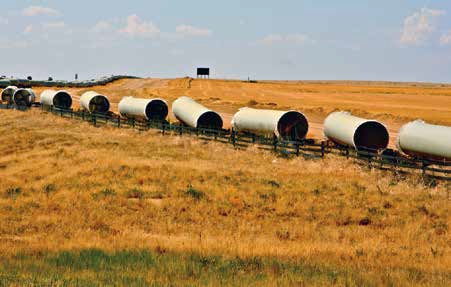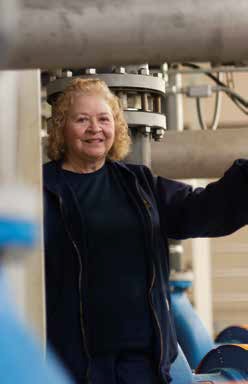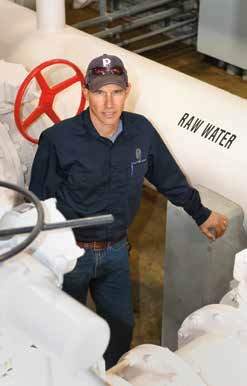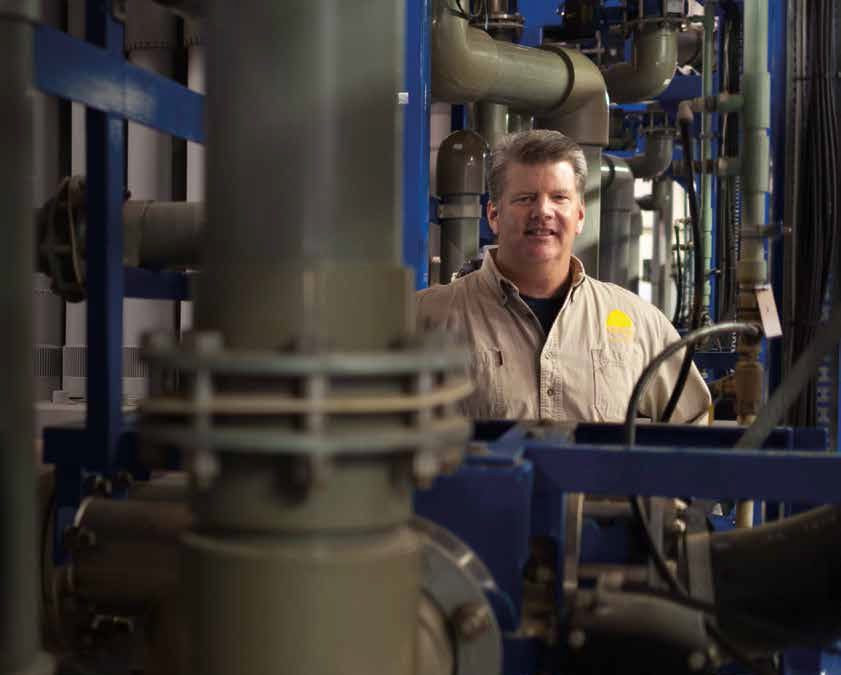A mostly buried network of infrastructure calls for our attention
It is just after 8 a.m. on a bright fall morning in Erie. At the Lynn J. Morgan Water Treatment Plant, Evelyn Crocfer, a plant operator, and Bruce Chameroy, chief of operations, have been on the job for an hour. They work in a sunny, window-filled room that is part operations center and part gleaming laboratory.
Dozens of water samples taken from different sites around the system sit on a counter. As a quality control measure, Crocfer checks the samples for various constituents first thing, carefully recording results as residents begin their day.
Across the room, a large computer screen glows with diagrams of the water treatment plant and the delivery system. This supervisory control and data acquisition (SCADA) system gives a detailed, underground view of everything water-related, from old town Erie out to its polished Vista Ridge neighborhood and golf course.

New pipe awaits installation in Aurora (top).Photo By: Ron Meyer
Chameroy and Crocfer check the computer and know almost instantly how much water is being consumed throughout the system, and what the capacity is in various storage tanks and reservoirs. This morning, the plant is quiet. It has adequate treated water stored to meet the day’s forecasted demand of 1.5 million gallons. This is enough water for Erie residents to cook breakfast, shower and get their children off to school. By contrast, that number exceeds 7 million gallons on hot summer days when sprinkler systems kick into high gear, and the plant ramps up to run nearly at capacity.
Chameroy and Crocfer are members of a full-time staff of seven responsible for ensuring that Erie’s rapidly growing population has enough water each day and that the precious liquid is safe to drink and tastes right. Their day starts with an inspection of this hypermodern water treatment plant, an automated facility that has sophisticated sensors, pressure gauges and filters that work around the clock so that Erie, population 20,000 and counting, can run its water system with a handful of people working 7 a.m. to 3:30 p.m. seven days a week, instead of the 24-hour staffing older facilities require.
Most water utilities use SCADA systems now, but large utilities, such as Denver Water still staff their systems round-the-clock. No matter how they’re staffed, water utilities must work closely with police and fire departments and residents to ensure they can respond quickly if and when there is an emergency. Sophisticated alarm systems tell on-call operators if there’s been a sharp change in water pressure, for example, which may indicate a major water main break.
Delivery systems are often supplied by vast collection systems that capture and transport mountain runoff. Erie, for instance, gets most of its water from the upper Colorado River west of the Continental Divide, through the Northern Colorado Water Conservancy District’s Colorado-Big Thompson Project. Erie’s water arrives each day, having originated as snowmelt on some of the tallest peaks in Rocky Mountain National Park, via a 13-mile tunnel beneath the Continental Divide, many miles of additional tunnels, multiple reservoirs, and a 37-mile pipeline that comes down from Carter Lake. From there, the water is delivered into raw water storage and held for treatment.
Roughly half of the water Front Range residents use comes from West Slope rivers. But dozens of communities, such as Castle Rock and Parker, rely on groundwater pumped from deep in the ground. Regardless of the water’s source, it all must be treated, and treatment methods vary depending on water quality and the utility’s age.
A Growing Investment
As Chameroy and Crocfer go about the quiet, vital work of delivering water, hundreds of other water professionals repeat the same rituals across the state. According to the Colorado Department of Public Health and Environment, some 2,050 public water systems are in operation here, ensuring Coloradans have enough water to cook, clean, water lawns and manufacture everything from beer to shoes.

Evelyn Crocfer is a water treatment plant operator for Erie, a small community that has implemented a
modern, automated system. Photo By: Kevin Moloney
Erie is one of the smaller systems in Colorado, and it is dwarfed by giant water delivery systems such as Denver Water. Once water reaches Erie, for instance, the town uses roughly 125 miles of pipeline to carry both raw and treated water for its 20,000 residents. Denver, at the opposite end of the scale, has about 3,000 miles of pipes for a system that serves 1.3 million people.
Whether the system is large or small, every foot of pipe must be monitored, maintained, repaired and replaced. It’s a massive invest ment each utility must make every year, and the size of that investment is growing. Denver Water, like other utilities, keeps careful track of its infrastructure. Water main breaks are major problems for utilities because they usually require extensive excavation to access and repair, are highly visible, and often disrupt traffic. Industry guidelines indicate that there should be no more than 15 main breaks annually per 100 miles of pipe, and Denver aims even lower, for no more than 13. The utility uses an extensive set of matrices to determine—based on age, use and location—which mains are likely to break, then sets out to repair or replace them ahead of time.
Nationwide, America’s aging water infrastructure is being eyed warily as governments study how best to replace old systems and make sure new water systems can meet the demands of a growing populace and ever-stricter water quality regulations. According to a new report by the American Water Works Association, “Buried No Longer,” U.S. communities must spend more than $1 trillion over the next 25 years to replace old water systems and install enough new storage and delivery capacity to cover additional growth.
Denver Water’s system is more than 100 years old. According to Greg Fisher, manager of Denver Water’s demand planning and budget, the expected lifetime of a traditional piece of water pipe is 60 years. So Denver, more than a young utility such as Erie, has larger maintenance costs to deal with aging pipes. Denver Water will spend $100 million maintaining its system in 2013. That amount will rise dramatically, peaking at $150 million annually around 2016 when the utility begins construction on the proposed Gross Reservoir expansion and replacement of its Moffat Treatment Facility, which was built in 1922.
Denver, like many utilities, will finance this work using the fees it collects from customers. Because of its size, Denver typically goes to the bond markets to issue its own bonds, using the proceeds to fund capital projects. It then pays off those bonds using money generated by water rates and fees.
Smaller communities typically don’t have the ability to go to the bond markets for large sums of money. And that’s where agencies such as the Colorado Water Resources and Power Development Authority come in. Each year, communities can borrow money from the authority to finance water delivery and treatment projects. In 2013, the authority will have $40 million available for drinking water projects and about $74 million available for wastewater.
The authority created its loan pool in 1989, issuing bonds and loaning out the proceeds to water utilities at low interest rates. This year the rate is about 2 percent. The authority also obtains grant money from the U.S. Environmental Protection Agency. In 2009, the authority received a one-time allotment of $56 million from the American Recovery and Reinvestment Act. So far, the authority has been able to provide loans to most of the communities that have requested them, but the need is increasing, says Keith McLaughlin, the authority’s assistant director of finance. According to McLaughlin, Colorado communities are projected to need roughly $8.2 billion over the next five years to repair and build drinking water and wastewater treatment facilities.
Some groups are advocating that Congress create a new finance authority to help fund infrastructure projects across the country. But many Colorado utility officials said they’re not interested in using federal money, in part because it comes with too many strings attached. “Our philosophy is that water should pay its own way,” says Steve Ryken, assistant general manager of the Ute Water Conservancy District in Grand Junction. “So when a new subdivision comes in, the infrastructure cost is paid for via tap fees.”
Each time a new home is built, Ute Water charges a one-time fee of $6,500. Ute Water, which serves 80,000 people in the Grand Valley, is adding roughly 20 to 30 taps a month. That rate is much easier to maintain, in terms of adding new pipes and treatment capacity, than it was just four years ago, when 80 to 100 new taps were going in every month. “Slow, steady growth is healthier, because you can keep up with your infrastructure needs easier,” explains Ryken.
Small utilities also find that banding together gives them much-needed political clout and financial muscle to maintain and expand their systems. In southwestern Colorado, several small communities and water districts linked up in 1980 to build a $14 million regional water treatment and distribution system. Cooperation proved the only way to get funding.
The system, known as Project 7, serves 45,000 people in communities from Olathe to Montrose to Delta and beyond. By sharing overhead costs, the project ensures even the smallest community has a safe, reliable water supply that can meet increasingly stringent water quality rules. “We think we hit a home run with this,” says Project 7 director Adam Turner.
Keeping Costs Down, Service High
No one doubts the effort it will take to fund water infrastructure projects in coming years, but utilities are finding ways to reduce those costs using conservation and technology. Denver Water had planned to replace two aging 20-million-gallon treated water tanks and a pump substation. But because the utility is using less water due to improved operational efficiencies and customers’ water conservation efforts, it has scaled back its plans. By building two 10-million-gallon tanks instead, Denver Water expects to save as much as $15 million. It may be able to eliminate the pump station as well.

Adam Turner oversees Project 7, a cooperative project implemented by a group of West Slope entities in the
1980s as an affordable route to clean water. Photo By: Barton Glasser
Technology is also making water systems more efficient and less expensive to operate. Twenty years ago, water stored in open reservoirs often grew stale and cloudy as sunlight heated the top layers of the water and allowed algae to bloom. Traditionally, utilities would add chemicals to the water to control the algae. Now towns such as Erie use “Solar Bees,” devices that look like giant bumblebees. As their name implies, they’re solarpowered mixers that draw cool, high-quality water from the bottom of the storage reservoirs and pump it to the top, creating a mixing cycle that improves water purity, clarity and taste without using chemicals or electricity.
Utilities are also improving their delivery systems to reduce water waste and loss due to evaporation. Erie is participating in a new pipeline project that will replace an open canal previously used for delivery. The new pipeline is expected to reduce evaporation losses by 10 percent.
As any water operator will tell you, a good day is when nothing goes wrong and a bad day can happen quickly. Because their work touches the lives of everyone in their communities, water operations staffers rely on constant testing and observation to keep their systems safe and running smoothly.
Small utilities such as Erie also rely on their neighbors. One day last summer, Chameroy saw a park maintenance crew spraying pesticide near one of Erie’s reservoirs. He knew immediately he would need to stop taking water from that storage facility.
Thanks to an emergency connect that Erie maintains with the towns of Louisville and Lafayette, Chameroy was able to shut down the intake from Erie’s reservoir, open the emergency interconnect, and use water from the partner towns to continue delivering safe water to residents. Sampling quickly determined that the reservoir near the spraying operation had not been contaminated. Without the help of its neighbors, Erie would have had to shut off water to residents while it was analyzing the water.
Back at the Lynn Morgan plant, Chameroy and Crocfer continue monitoring the pulse of their small, modern water facility, where big things are afoot. In 2013, Erie’s new recycled water plant will deliver its first water to the city’s parks and the golf course at Vista Ridge. The town’s homeowner associations will be given access to a state of-the-art rain and moisture system, so that their sprinklers know when trees and grasses in common areas need water and when they don’t.
By the end of the day, Chameroy and his team are ready to set the system on auto-pilot for the night. They check their gauges and monitoring systems one more time, make sure their alarms are set in case something needs their attention before morning, and lock their office doors, knowing the people who call Erie home will have all the water they need until the staff members return to their posts in the morning.


 Print
Print